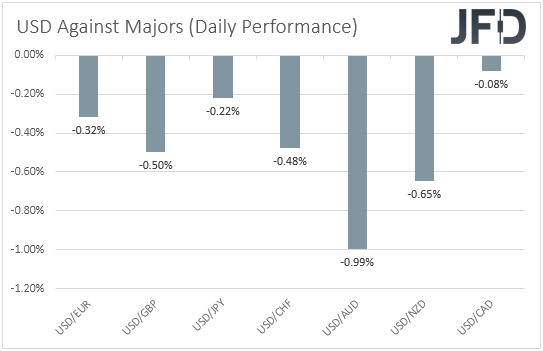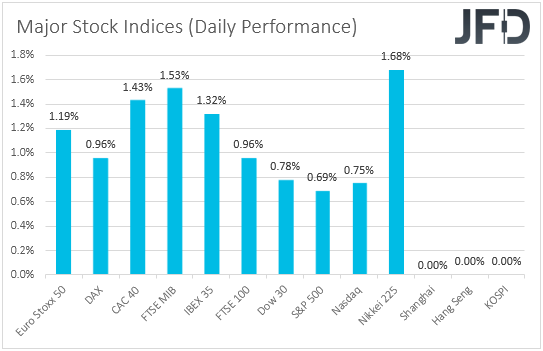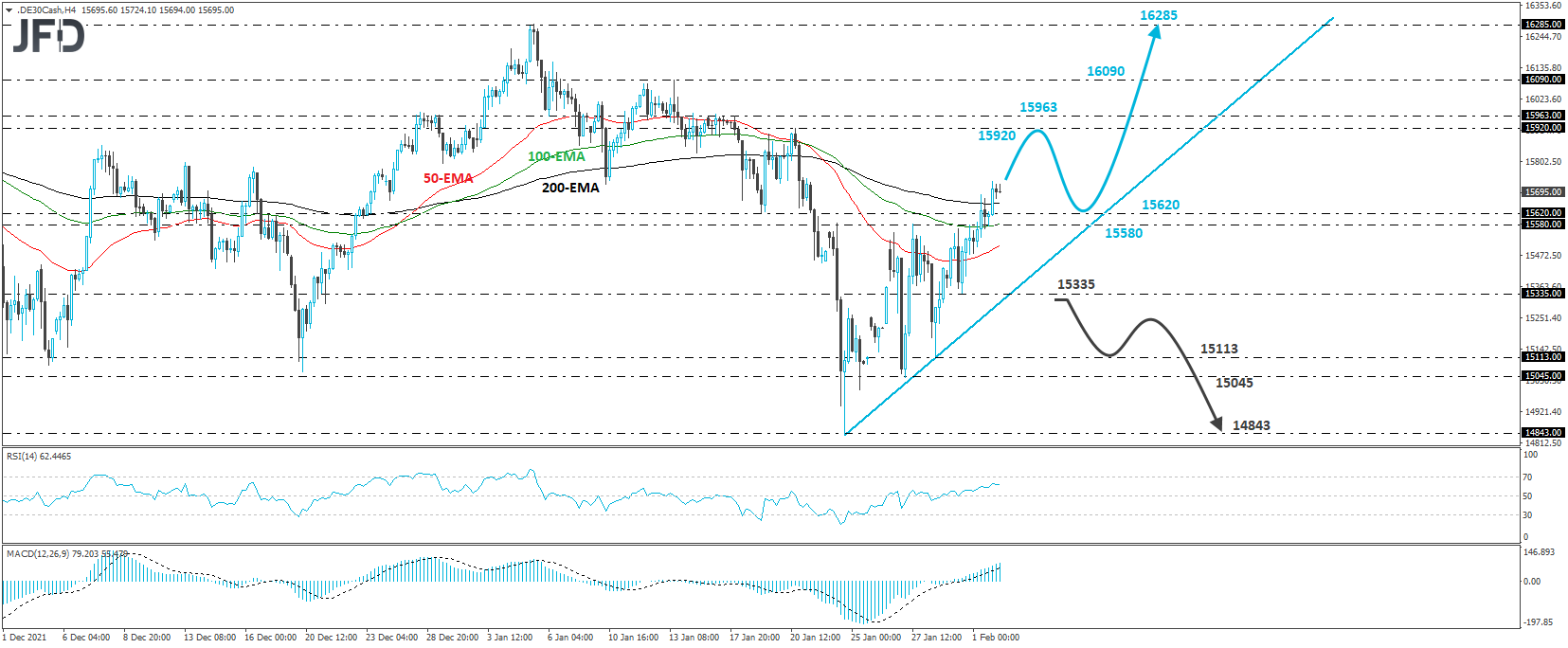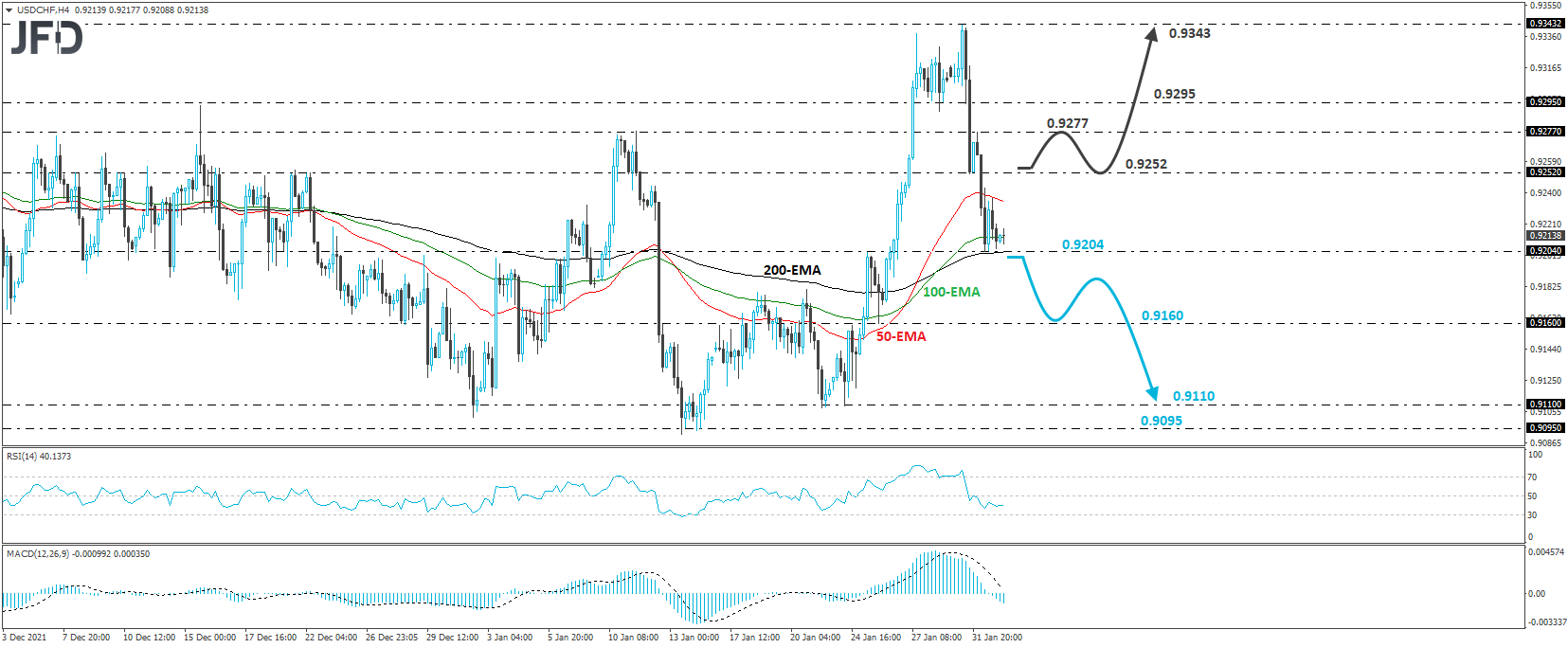The US dollar continued to drift south. At the same time, equities extended their recovery, perhaps as a couple of Fed officials disappointing market expectations of nearly five increases by the end of the year, and perhaps a 50 bps hike at the March meeting.
Today, we have Eurozone’s CPIs, which are expected to slow notably, but bearing in mind that the German rates remained unchanged, we would consider the risks as tilted to the upside.
USD Drifts South, While Equities Continue to Gain
The US dollar continued trading lower against all the other major currencies on Tuesday and during the Asian session Wednesday. It lost the most ground versus AUD, NZD, and GBP, while it underperformed the least versus CAD.

The weakening of the US dollar, combined with the strengthening of the risk-linked Aussie and Kiwi, suggests that the financial world continued trading in a risk-on mode.
Indeed, turning our gaze to the equity market, we see that major EU and US indices were a sea of green, with the increased appetite rolling into the Nikkei 225 session today. The other Asian indices under our radar remained closed.

Yesterday, we noted that Monday’s rebound in equities may have resulted from portfolio rebalancing. This may continue for a while more, despite no significant change in the fundamental outlook. This may have indeed been the case, but remarks by some Fed officials may have also encouraged some more risk-buying.
Philadelphia Fed President Patrick Harker said yesterday that it might be appropriate to proceed with four hikes this year, at a time when market participants are pricing in nearly five liftoffs. In contrast, St. Louis Fed President James Bullard, who is considered to be a hawk, said that he does not favor double hikes, disappointing those expecting a 50 bps increase at the upcoming Fed meeting.
As for our view, it has not changed much. Yes, some further advances may be in the works for a while more, but we are still reluctant to call for a long-lasting recovery. Expectations are still for higher rates this year in most major economies, and on top of that, uncertainty surrounding Ukraine remains elevated.
So, as we noted yesterday, we prefer to trust some more recovery in Eurozone indices, and this is because we see the case for the ECB to lift interest rates much slower than the Fed.
Speaking about the Eurozone and the ECB, today, we get the bloc’s preliminary CPIs for January, with both headline and core inflation expected to have slowed notably. However, bearing in mind that Germany’s rates did not decline as their forecasts suggested and instead stayed unchanged, we would consider the risks as tilted to the upside.
Better-than-expected numbers could allow some euro traders to maintain their bets with regards to a slight rate increase by the ECB later this year, which, in a weakening USD environment, could help the euro gain somewhat.
However, we need to be careful. Any further recovery in the euro could stay very limited and short-lived. Remember that, tomorrow, we have an ECB decision, and if the Governing Council sticks to its guns that a rate hike this year is unlikely, we could see the euro coming back under renewed selling interest.
DAX – Technical Outlook
The German DAX cash index traded higher yesterday, clearing the 15620 barrier, marked by the inside swing low of Jan. 19. Overall, the index continues to print higher highs and higher lows above an upside support line drawn from the low of Jan. 24, and thus, we would see decent chances for more advances.
We believe that the bulls could stay in charge for a while more and perhaps target the 15920/63 territory, marked by the highs of January 20th and 18th, respectively. If they are unwilling to stop there, we could see them pushing towards the high of Jan. 13, at 16090, the break of which could carry extensions towards the peak of Jan. 5, at 16285.
On the downside, we would like to see an apparent dip below 15335 before we start examining whether the bears have gained the upper hand. Such a move could confirm the break below the aforementioned upside line and perhaps allow declines towards the 15113 or 15045 zones, marked by the lows of Jan. 28 and 27, respectively. If those barriers cannot halt the fall, then we may see extensions towards the low of Jan. 24, at 14843.

USD/CHF – Technical Outlook
USD/CHF has been in a tumbling mode since Jan. 31, when it hit resistance at 0.9343. The slide hit support at the 0.9204 level and paused slightly above it. In our view, the short-term bias remains to the downside, but before we start examining further declines, we would like to see an apparent dip below 0.9204.
A decisive break below that hurdle could pave the way towards the low of Jan. 25, at 0.9160. If the bears are unwilling to stop there, its break could carry more significant bearish implications, perhaps setting the stage for declines towards the 0.9110 and 0.9095 zones, marked by the lows of Jan. 24 and 14, respectively.
To start examining a potential recovery, we would like to see a rebound back above 0.9252, a resistance marked by the inside swing low of Jan. 31. This could initially aim for yesterday’s high, at around 0.9277, the break of which extends the advance towards the inside swing low of Jan. 28, at 0.9295. If that zone cannot stop the bulls either, we could see them climbing back to the peak of Jan. 31, at 0.9343.

Elsewhere
Besides the Eurozone CPIs, we also get the US ADP employment report for January, with the forecast suggesting that the private sector added 208k jobs from 807k in December.
